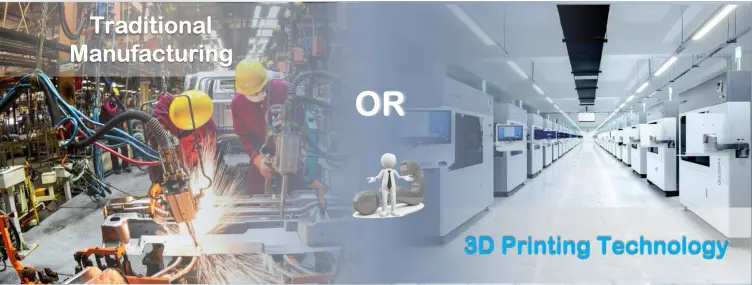
Introduction
As a digital manufacturing technology, 3D Printing has been widely used in the manufacturing, healthcare, aerospace, and other industries in recent years. More and more people discussion about “whether 3D Printing technology can replace traditional manufacturing”. So, is there a substitute relationship between 3D Printing technology and traditional manufacturing?

Comparisons
Traditional manufacturing usually involves mass production of the same product, which requires the manufacture of a large number of molds and production lines, as well as a lot of human and material resources. 3D Printing technology, on the other hand, can produce various different products using a single machine, is more convenient to manufacturers.
In addition, traditional manufacturing requires multiple production processes, including raw material procurement, production process arrangement, processing, assembly, and quality inspection, among others. 3D Printing technology can complete the entire manufacturing process in a single process, greatly improving production efficiency and reducing costs.
Advantages of 3D Printing technology
Reduced manufacturing costs: 3D Printing technology requires only a small amount of raw materials and a single machine to complete the production process. As an additive manufacturing technology, there is very little material waste during the manufacturing process, effectively reducing production costs.
Improved production efficiency: 3D Printing technology can produce a large number of products in a short period of time, greatly improving production efficiency. Traditional manufacturing requires a lot of time and effort to manufacture molds and production lines, while 3D printing can directly complete the production process on a single 3D printer.
Personalized production: Traditional manufacturing produces the same product using molds, while 3D Printing can customize personalized products according to customer needs. This production mode can bring higher customer satisfaction and also increase the added value of products.
Rapid design and iteration: 3D Printing technology can quickly manufacture prototypes for validation and testing according to a designer's design, thus shortening the product development cycle and allowing for rapid product iteration. Traditional manufacturing requires time and cost to manufacture molds and production lines before formal production, and if there are design defects during the process, molds and production lines need to be re-manufactured, which can slow down the development process significantly.
Flexible production: 3D Printing production can be completed on a single 3D printer, and different types of products only require changes to the printing files and program settings, achieving flexible production.Traditional manufacturing requires redesign and manufacturing of molds and production lines, which requires a lot of time & cost.
Reduced environmental pollution: Traditional manufacturing produces a large amount of waste and exhaust, which causes significant environmental pollution. 3D Printing technology can use materials directly for production without processing, reducing waste and emissions during the production process and thus reducing environmental pollution.
Shortcomings of 3D Printing technology
High manufacturing costs: Although 3D Printing technology can reduce manufacturing costs, the cost of its machines and materials is still high. In the case of mass production of the same product, traditional manufacturing is still a more economical and feasible choice.
Product quality inferior: 3D Printing technology produces products by stacking materials layer by layer, which makes products susceptible to defects and may have weaknesses in durability compared to traditionally manufactured products.
Slow production speed: Although 3D Printing technology can produce a large number of products in a short period of time, it is still slower than traditional manufacturing for mass production of the same product.
Conclusion
Certainly, both 3D Printing technology and traditional manufacturing technology have their own advantages. However, social development is complex, and it requires both stable and continuous production, as well as iterative product updates. At this stage, traditional manufacturing processes play a more important role in social development. But with the development of 3D Printing technology, such as the large size industrial 3D printer comes out, which referred industrial sls printing technology, is getting closer to mass production, we believed that it will play an increasingly important role in the manufacturing industry. The organic combination of 3D Printing technology and traditional manufacturing industry can promote social development better.